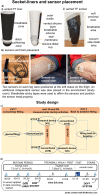Moisture mitigation using a vented liner and a vented socket system for individuals with transfemoral amputation
- PMID: 37783779
- PMCID: PMC10545693
- DOI: 10.1038/s41598-023-43572-2
Moisture mitigation using a vented liner and a vented socket system for individuals with transfemoral amputation
Abstract
Sweating and heat buildup at the skin-liner interface is a major challenge for persons with limb loss. Liners made of heat-non-conducting materials may cause sweating of the residual limb and may result in liners slipping off the skin surface especially on a warm day or during high activity, causing skin breakdown and affecting limb health. To address this, we evaluated the efficacy of the vented liner-socket system (VS, Össur) compared to Seal-In silicone liner and non-vented socket (nVS, Össur) in reducing relative humidity (RH) during increased sweat. Nine individuals with limb loss using nVS were randomized to VS or nVS and asked for activity in a 20-min treadmill walk. RH was significantly attenuated (p = 0.0002) and perceived sweating, as reported by prosthesis users, improved (p = 0.028) with VS, patient-reported comprehensive lower limb amputee socket survey (CLASS) outcomes to determine the suspension, stability, and comfort were not significantly different between VS and nVS. There are limited rigorous scientific studies that clearly provide evidence-based guidelines to the prosthetist in the selection of liners from numerous available options. The present study is innovative in clearly establishing objective measures for assessing humidity and temperatures at the skin-liner interface while performing activity. As shown by the measured data and perceived sweat scores provided by the subjects based on their daily experience, this study provided clear evidence establishing relative humidity at the skin-liner interface is reduced with the use of a vented liner-socket system when compared to a similar non-vented system.
© 2023. Springer Nature Limited.
Conflict of interest statement
There is no financial and institutional conflict of interest to the SCG, JD, BH, LDT, SG, CKS and SR. JVK, MSR, KL are employees of Össur ehf.
Figures





References
-
- Balk, E. M. et al. in Lower Limb Prostheses: Measurement Instruments, Comparison of Component Effects by Subgroups, and Long-Term Outcomes AHRQ Comparative Effectiveness Reviews (2018). - PubMed
Publication types
MeSH terms
LinkOut - more resources
Full Text Sources
Medical
Research Materials

